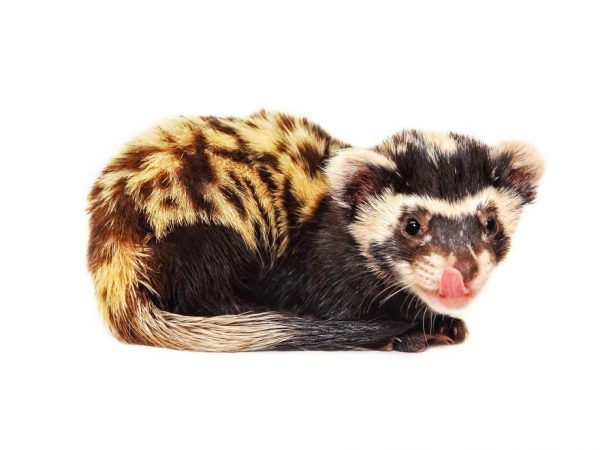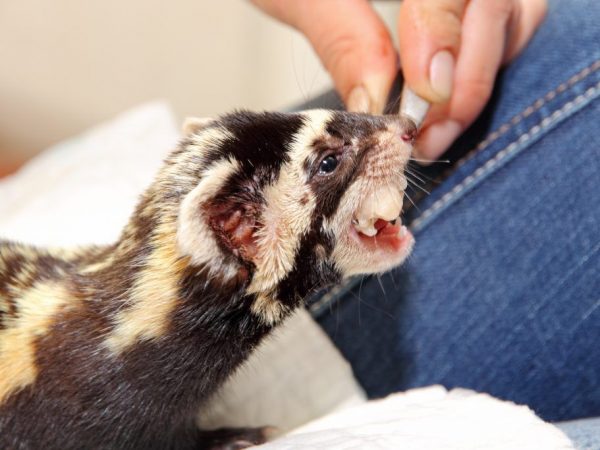Description ferret breed dressing
Ferret Dressing is very similar in appearance to the common ferret, but it is not so common in the wild.

Characteristics of the ferret breed Dressing
The Bandage ferret is considered a predator, but this does not prevent it from maintaining good relations with people. That is why this particular type of animal quickly gained its popularity as a pet.
Habitat
In nature, the ferret Bandage lives in the low-lying part of the mountains at a level of 3-4 km from the ground.
You can find these animals not far from their holes or directly in their home. These small animals live on the territory of the Baltic Peninsula and partly on the lands of China. Russia is another place that these predatory animals have chosen.
Ferret Bandage leads an active nocturnal lifestyle, sleeps during the daytime.

Habitat Bandages
This animal lives in parks, vineyards, vegetable gardens. He treats people positively, because he gets used to the fact that they are always around. The predator is very smart, he builds several houses in different places on the territory of about 500 m. He does this for his convenience and safety. A large number of houses allows the animal to hunt freely and successfully hide from predators.
Description and nutrition
Outwardly, as already mentioned, the bandage ferret is very similar to its relative, the common ferret. On average, the length of the animal's body is 28-35 cm. The tail reaches 13-17 cm in length. The body of a ferret has an average weight of 300-700 g. The rodent's ears are large, rounded, and white stripes are drawn on the tips.
The animal's muzzle is slightly flattened. On the head, as well as on the ears, there is a white stripe. The ferret has a thick, smooth coat. By color, the predator of the Bandage breed differs from the usual species of ferrets. The coat shimmers with brown, yellow, black, white. In the photo, she does not seem as bright as live.

Feeding ferrets of breed Dressing
Ferret Ligation prefers small prey in its diet, those animals that live in burrows or on tree trunks. The prey can be a mouse, gopher, jerboa, hamster, gerbil. In hunting, the main assistant of rodents is scent. The animal can climb up to 600 m along the burrow without a single exit to the outside. Also, this type of rodent loves to dilute its daily diet with fruits, for example, melon, watermelon, pumpkin or various types of wild berries.
Lifestyle
The bandage is active while hunting at night. If there is no prey, the animal behaves calmly. The ferret has long claws, with the help of which it digs holes. If the strength of the claws is not enough, the animal connects to the work and teeth. Bandaging marks can be recognized by the following criteria:
- If you come across a bandage footprint in the sand, it should look like a common ferret's footprint.
- Ferret ligation does not leave claw marks on firm ground.
- The rodent of this breed is so nimble and agile that you can often find a footprint on which there will be prints of all four paws at once.

The dressing is active
Thanks to its developed hunter skills, the animal can get at least 4 carcasses within an hour.In rare cases, Bandage goes hunting with a fox. The redhead scares small rodents, they hide in burrows from fright, and the ferret has an excellent opportunity to catch its prey.
When Ferret Bandage senses a foreign smell, hearing, scent and sight are strained as much as possible. To avoid meeting with a predator, the animal stands on two legs, flexes its back as much as possible and stretches out its neck. He does this in order to cover as much territory as possible. The look becomes vicious, the tail is pressed.
Reproduction
Rodents reach puberty at the age of 7-12 months. Males are able to successfully fertilize a female for an average of 5-7 years. The female can bear and give a healthy offspring within 3-4 years of life.
Females of the Bandage breed have proven themselves from a good side. They are responsible for motherhood and are able to feed and raise not only their own, but also other people's babies. For dressings, sexual activity is divided into 4 periods:
- Peace. This period lasts from the first pregnancy (or when heat is interrupted) until the second heat occurs. During this period of time, no changes occur in the female's body.
- Before the start of the sexual hunt. This period falls in winter, around February, and lasts about 10-15 days. During this cycle, the female and male become sexually mature.
- Sexual hunting. This period of sexual activity falls in the spring, when day begins to prevail over night. This time falls mainly in the middle of March. Females, which first reached sexual maturity, go out to hunt a little later than the rest, around the end of April. By and large, a female's hunt depends on many factors. If the female is sick, exhausted, or living conditions before the hunt were unfavorable, she will go hunting much later than the rest of the females.
- After the hunt. During this period, the female bears the fetus. After giving birth, the female's body returns to its previous state. If mating did not occur or there was an abortion, at this stage the girl, after a short period of time, is in heat again.
In places where dressings are bred, there are about 5 females per male. Mating animals is recommended in the daytime, preferably in the morning. Sexual intercourse lasts a minimum of 15 minutes and a maximum of 2 hours. After the morning mating for the evening, the male can again be bred with the female.
When mating, the ferret of this breed behaves calmly. There is no need to worry about the fact that during mating, the female may rush to the male or vice versa. Males, which are distinguished by their mating activity, receive additional nutrition.
Conclusion
The rodent's burrow can reach more than 100 m and have several exits outside.
The fauna of wild rodents is amazing. But increasingly, these animals are becoming pets. The dressing was no exception. For many people, their cute appearance sunk into the soul, which is why they began to be taken to their homes. The bandage is one of the few animals that get along well with people.

